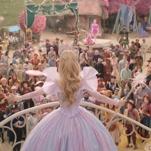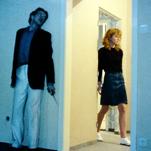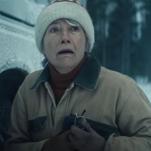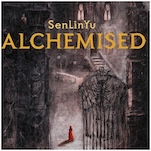The 20 Best Simpsons B-Plots
Photos via Fox, The Simpsons, YouTube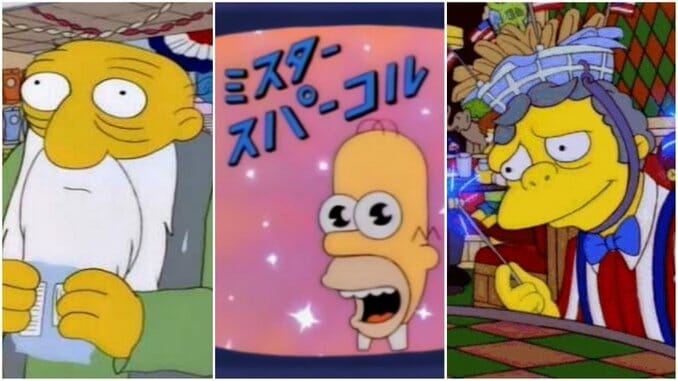
To date, there have somehow managed to be 31 seasons and 679 episodes of The Simpsons. Edit: In 2024, this is now 35 seasons, and 764 episodes.
Consider the magnitude of those numbers. They make The Simpsons the longest-running scripted, prime time U.S. TV series of all time, both in terms of number of seasons and number of episodes. In fact, if we’re only talking seasons, The Simpsons has a 10 season lead over second place Law & Order: SVU, which has somehow hung on for 21. The Simpsons, meanwhile, exists in its own separate tier—there’s almost nothing you can even compare it to at this point.
Not bad, considering that the show has been a shell of its former self for more than twice the time it was ever at its peak. If you want a testimonial to what a revelation The Simpsons could be during its golden era, look no further than how far the goodwill of that era managed to carry it after its quality dipped. No other series would have survived so long in its currently trashy state, because no other series’ classic era is more revered. It’s still coasting on the strength of episodes that are more than 20 years old.
What made those episodes so great, then? Well, it wasn’t always the central storylines. Many classic Simpsons episodes are defined by a dual structure—they contain both a primary “A” plot that is the focus of the narrative (and often contributes the episode title), and a secondary “B” plot that is tangential (or completely unrelated) to the rest of the story. These “B plots” were often a boon to Homer in particular, as they represented a way for writers to shoehorn in unrelated jokes involving the series’ most popular character into episodes that were otherwise focused around other members of the family. As a result, there are a lot of great Homer B plots, but they’ve also been used to great effect with secondary characters such as Mr. Burns, Moe, or even Jasper Beardly.
Here, then, are the 20 best B plots in the history of The Simpsons. And yes, they focus primarily on the classic era … because why wouldn’t they?
20. “Happy Dude”/Autodialer
Episode: “Lisa’s Date With Density” S8E7
A minor distraction in an episode that is otherwise about Lisa’s burgeoning, oddball romance with Nelson Muntz, Homer’s “Happy Dude” telemarketing scheme is pretty much Simpsons B-plot 101: Homer-centric, snappy and totally unrelated to anything else in the episode. It’s a perfectly Homer thing to do, to ignore his actual career at the power plant in the hopes of making a few extra dollars by swindling the residents of Springfield over the phone. You can file this among Homer’s various attempts at moneymaking schemes, from bootlegging to grease-selling, which he himself references in season 6’s “Grampa vs. Sexual Inadequacy,” saying: “After years of disappointment with ‘get rich quick’ schemes, I know I’m going to get rich with this scheme … and quick!”
Highlights include Homer’s obliviousness to his own role in keeping Ned and Maude up all night, and plenty of great lines from Chief Wiggum, including him telling Homer to “bring that evidence with you; otherwise I got no case and you’ll go scot-free.”
19. Frostillicus
Episode: “Lisa the Simpson” S9E17
Like the A plots of The Simpsons, the series B plots had a tendency to swing ever more absurd as the show approached the twilight of its golden era, which many fans peg as season 9. This one is a good illustration, both for the fact that it focuses around two ancillary characters (Apu and Jasper) and content itself, which takes what might have been a simple throwaway gag (Jasper climbing inside an ice cream freezer and being frozen) and expands it into an entire secondary plot. As it turns out, Jasper, wishing to see “the future” before his approaching demise, purposefully has frozen himself in order to enter a state of suspended animation … something Apu takes advantage of by dressing him as a Viking-helmeted “Frostillicus” and charging, as Bart would say, “two bits a gander.”
This allows for some solid Apu humor, as various elements of the Kwik-E Mart are stylized as freak show attractions, such as “The Floor That Just Won’t Come Clean.” Of course the stinger—and by far the best-remembered bit from this B plot—is Jasper’s delighted belief that he’s in the future once he accidentally thaws out, and his exclamation upon seeing a display full of junk food: “Moon Pie. What a time to be alive!”
18. Mojo the Helper Monkey
Episode: “Girly Edition” S9E21
As if it really needs to be said: Homer really isn’t a great guy. He’s uncaring, thoughtless and is capable of being quite cruel, even though that cruelty is often funny in spite of itself. Poor Mojo, Homer’s “helper monkey” in this season 9 episode, might be the ultimate illustration of that. By this point in the series run, Homer’s laziness was truly being played up to absurd degrees, and his systematic destruction of this monkey’s life might mark a high point in that regard. It’s a bit of a meanspirited B plot, but you can’t help but chuckle when Marge says the morbidly obese monkey was meant to be sweeping the floors and cleaning the gutters, and Homer replies “What do you want? His cholesterol is through the roof,” as if it isn’t all his fault.
Mostly, though, this one makes the list for the oft-quoted stinger, when Homer returns the monkey to its service animal organization, and he types a final plea: “Pray. For. Mojo.” Disturbingly funny.
17. The Ribwich
Episode: “I’m Spelling as Fast as I Can” S14E12
A good Simpsons B plot has a tendency to sometimes eclipse the A plot entirely, and that definitely happens in this episode, which is ostensibly about Lisa going off to Canada for a worldwide “Spellympics” tournament. This is as late into the series run as you’ll see on this list, and the episode itself is fairly middling, but for this fascination with Krusty Burger’s “Ribwich,” an extremely thinly veiled parody of the McDonald’s McRib. It gets a lot of time in the episode, from the opening moments when we see a Ribwich commercial that contains one of Krusty’s most immortal lines: “Try my new Krusty Ribwich! Mmm … I don’t mind the taste!”
The sequences of Homer first trying a Ribwich and experiencing a sensory overload have taken on a life of their own in Simpsons meme culture in the years that have followed, but it’s Krusty who really makes this whole B plot sing. He has all the best lines, especially near the end when he claims that the Ribwich is gone because the animal it was made from is now extinct. In response to guesses like “the pig?” and “the cow?”, he responds with the following: “You’re way off! Think smaller. Think more legs.” It’s a great, gross moment from an era when it was clear to most fans that the best days of The Simpsons were long behind it.
16. CompuGlobalHyperMegaNet
Episode: “Das Bus” S9E14
Few Simpsons B plots are as thoroughly divorced from the main story as this one, given that it’s about Homer setting up an online business while the primary A plot involves the kids fending for their lives on a deserted island. These segments don’t touch each other even a little bit, but it’s another case where the Homer plot may be more memorable than the rest of the episode.
Homer has never exactly had a good relationship with computers, as episodes like “King-Size Homer” have often illustrated his lack of any basic technical savvy. This B plot just revels in it, from the opening observation of “Ooh, they have the internet on computers now,” to his attempt to aid Comic Book Guy in beefing up his connection speed. But it’s the Bill Gates cameo that steals the show, exemplified by his incredible self-deprecating line “Don’t let the haircut fool you; I’m exceedingly wealthy.”
15. Bart in School at Cypress Creek
Episode: “You Only Move Twice” S8E2
This episode, which sees the Simpson family moving to spiffy Cypress Creek so Homer can work for megalomaniacal (but very friendly) new boss Hank Scorpio, essentially makes the entire rest of the family’s experience in Cypress Creek into a B plot, but both Marge and Lisa’s segments are quite short and perfunctory. Lisa in particular gets the short straw, as the only downside of the move for her is “I’m allergic to things.” Bart, on the other hand, experiences something very different, being thrust into a more realistic school system than the doldrums of Springfield Elementary, finding out only then just how far behind he is on an educational level. Consequently, he’s shipped off to a satirical depiction of remedial school classes, the “Leg Up” program, where he laments the fact that he’s meant to catch up to other kids by “going slower than they are.”
This is a B plot that actually feels influential upon a later Simpsons episode from the same season, “Homer’s Enemy,” in that it asks essentially the same question. Instead of “How would a real person react if forced to interact with Homer?”, it’s “How would Bart function in a real classroom?” And the answer, unsurprisingly, is “not well.” The cast of bizarro kids around him are a frightening bunch, leading to one of the episode’s best observations: “I’m surrounded by arsonists, and kids with mittens pinned to their jackets all year round!”
14. Mr. Burns, Hypochondriac
Episode: “$pringfield” S5E10
More Mr. Burns is almost always a good thing. Homer’s boss may very well hold the title for the most Simpsons episodes structured around a character who isn’t actually a blood relative of the Simpson family, whether in protagonist or antagonist roles … although really, it’s typically the latter. You don’t just steal the city’s sunlight (or the holiday of Christmas for several years) without being seen as “something of an ogre,” as Smithers so eloquently once put it.
It’s not surprising, then, that Mr. Burns can easily carry classic B plots as well, as in this episode that revolves around his self-named casino and the emergence of Marge’s subsequent gambling addiction. The emotional core of the episode revolves around Marge’s abandonment of her family and Lisa’s need for a perfectly Florida-shaped costume, but all the while, Mr. Burns is watching on from confinement, first appreciating the sheer money-making efficiency of the casino before eventually devolving into madness. This version of Burns, a long-haired and long-nailed parody of eccentric, shut-in geniuses like Howard Hughes, is frequently hilarious, voicing his distrust of freemasons and “microscopic germs.” His chief accomplishment is of course the invention of the “Spruce Moose,” a tiny but apparently functional plane that will “carry 200 passengers from New York’s Idlewild Airport to the Belgian Congo in 17 minutes!” So hop in, won’t you?
13. The Family’s Big Day in NYC
Episode: “The City of New York vs. Homer Simpson” S9E1
Man, there are a lot of season 9 entries here, aren’t there—perhaps an indication of the way the show’s writers were beginning to run out of natural storyline avenues as The Simpsons neared the end of its golden period. This one, though, isn’t lacking a strong central narrative: Homer has to travel to the city of New York to retrieve his lost car, regrettably parked between the World Trade Center towers, which resulted in this episode being stricken from reruns for years after the Sept. 11 attacks. The problem: Homer has an intense grudge against the city, resulting from a visit as a young man where he was set about by criminals, pimps, and of course … the C.H.U.D.s.
The rest of the Simpsons, however, are ecstatic about the chance to visit New York, even if it means taking a bus ride that somehow involves “transferring in Atlanta twice.” While Homer’s day is a series of frustrating encounters that continually push him closer to the brink, the rest of the Simpsons are soaking in that authentic NYC culture, from the grime of the subway to the grime of other locations as well. Still, this B plot might have slipped off the list, but for the episode’s unexpected musical highlight: a long look at Broadway show Kickin’ It: A Musical Journey through the Betty Ford Center. It’s arguably the last truly great musical number in the history of The Simpsons, finishing prominently in our list of the best Simpsons songs for lines like “No more looking pale and thin; no more bugs beneath your skin!”
12. Grandpa in the Workplace
Episode: “Lisa vs. Malibu Stacy” S5E14
Grandpa Simpson B plots aren’t nearly as common as ones involving other members of the family, but they do exist. Alongside Lisa’s quest to combat sexism in this episode is the tangential desire Grandpa experiences to prove he’s still vital and useful, which results in him reentering the workforce at a local Krusty Burger. It’s a bit of a regurgitation of the main plot from season 4’s “The Front,” which saw Grandpa roped by the kids into posing as an Itchy and Scratchy writer, but “The Front” never featured “a burger that can take a bite out of you!”
We get some classic, crotchety Grandpa humor here, such as his seemingly complete lack of knowledge of “French fries,” and also more than a little satire of the the squalid conditions of your average fast food franchise, where the secret sauce is made by “putting this mayonnaise in the sun.” I particularly enjoy Grandpa’s return to normalcy at the end of the episode, which is catalyzed by the realization that hey, maybe this burger chain should be offering soft boiled eggs on the menu!
11. Swear Jar
Episode: “Bart the Lover” S3E16
“Bart the Lover” is undoubtedly one of the greatest episodes in the history of the series, and one where we likely remember the primary plot (Bart tricking and wooing Ms. Krabappel via mail) more than the B plot, but Homer’s swear jar ultimately complements the story nicely. He’s talked into the idea by Flanders and Marge, who steals the best line of the subplot with a reminiscence about her rarely referenced father, who apparently used to “curse a blue streak” after leaving the Navy, which “almost cost him his job as a baby photographer.”
We subsequently then get montages at various points of Homer contributing to the swear jar, a clever contrivance that allowed the writers to suggest profanity throughout this episode without actually using much of it, while also inserting amusing phrases like “Fiddle-dee-dee, that will require a tetanus shot.” The payoff is a new doghouse for Santa’s Little Helper, and a revisit of the running gag of Homer’s relative indifference to poor little Maggie.
10. James Woods at the Kwik-E-Mart
Episode: “Homer and Apu” S5E13
There really aren’t many Simpsons B plots that revolve around celebrity guest stars, as most of the time when a celeb appears on The Simpsons, it’s as a brief cameo, or as an integral part of the A plot. That makes this one fairly unique, as the James Woods material is separated quite neatly from Homer’s story with Apu—he even has multiple scenes on his own in the Kwik-E-Mart as he learns the ropes. This episode also does a far better job than average of rendering the screen presence of a guest star, translated into Simpsons animation—from the facial expressions to the constant hand gesturing, they really nail the irritable energy of Woods’ performance, making him feel like one of the most “real” guest stars to ever be featured on the show.
His material in grappling with the Kwik-E-Mart job is likewise hilarious, whether it’s swearing at the cheese in his oven, threatening Jimbo Jones or griping at his agent: “How can it be the same movie if they’ve changed my character from a tightly wound convenience store clerk to a jittery Eskimo firefighter?” He even develops a bit of hero worship for Apu, recognizing the fortitude it takes to survive a job that so frequently seems to involve taking bullets to the chest.
9. School Uniforms
Episode: “Team Homer” S7E12
I didn’t initially think the school uniform subplot of “Team Homer” would warrant a top 10 position, but that was before remembering just how many great jokes are sprinkled through this Springfield Elementary-centric B plot. The trouble is all kicked off by Bart’s MAD Magazine “down with homework!” shirt, which proceeds to send Skinner spiraling back into Vietnam trauma, including the hilariously detailed description of the stew he had in captivity and has now been seeking out in the states for years, featuring “fish, vegetables, prawns, coconut milk and four kinds of rice.”
Things only pick up more with the arrival of the kids’ slate grey, French-inspired uniforms from “Mr. Boy of Main Street,” and its female line “Mr. Boy for Girls,” which quickly sap their individualism and capacity for rebellion, turning a game of tag into one with phrases like “Now you are the one who is it.” The jokes are layered on densely, from the “blinking in unison” bit, to Nelson forgetting his own catchphrase, but it’s Superintendent Chalmers who ultimately steals the show here, especially in his absurd reasoning for filling out his evaluation sheet: “I am going to give this school a perfect 10! I’ll just write the zero first … now a vertical line to indicate the 1.”
8. Bart’s Factory
Episode: “Homer’s Enemy” S8E23
This is another classic Simpsons B plot that essentially exists in an entirely separate universe from the main story, about Homer vs. Frank Grimes, crossing over only for the briefest of moments when Homer ventures to mention that his son “owns a factory downtown.” I love that they included that line, though, for the implication that not only are Marge and Homer aware that Bart is spending his time at an abandoned factory in Springfield’s seedy industrial sector, but they also don’t care about it.
This B plot exists simply to give Bart (and then Milhouse) a space to run amok, and illustrate how we behave when unconstrained. Bart’s simple actions, like picking up a screw and tossing it to the opposite end of the factory just to see what happens, capture a sense of pure, unchecked childhood id—as do experiments like dumping a bunch of adding machines into industrial waste, or rocketing around the huge factory in a fire extinguisher-powered rocket chair. But the highlight is how Bart immediately assumes a tyrannical manager position, foisting pointless work onto Milhouse just to feel powerful, which ends in forcing the unlucky junior Van Houten into the role of night watchman. Milhouse, milquetoast that he is, quickly comes to grips with this seeming new normal: “So this is my life. At least I’ve done better than Dad.”
7. Maggie in Daycare
Episode: “A Streetcar Named Marge” S4E2
Maggie likewise isn’t the sort of character who receives a lot of B plots, but this one stands out as perhaps the most memorably Maggie-focused story The Simpsons ever bothered trying to tell. While Marge is busy with rehearsals for her musical adaptation of A Streetcar Named Desire, Maggie is shipped off to the Ayn Rand School for Tots, where satire of the author’s objectivist philosophy provides early laughs. Where else would one hear a baby’s desire for a bottle being described as tantamount to saying “I am a leech!”, or the stated goal of “developing the bottle within”? The reality of the daycare frames it as something of a prison camp, where babies are doing hard time.
This of course sets up the structure of an extended parody of 1963’s classic POW escape film The Great Escape, as Maggie and the other babies display shocking intelligence in liberating their imprisoned pacifiers—sequences that are bolstered by the inspired inclusion of The Great Escape’s theme music. Not to be lost, however, are the subsequent allusions to other films as well, notably Alfred Hitchcock’s The Birds when Homer and the kids arrive to pick Maggie up. This episode is particularly rich in pop cultural references, which is something The Simpsons excelled at during its golden period.
6. Homer’s Giant Sandwich
Episode: “Selma’s Choice” S4E13
We’ve seen Homer bond with potential foodstuffs several times over the years, whether it’s Pinchy the lobster or Spider-Pig from the Simpsons feature film, but at least those were living creatures. His depth of attachment to a rotting, 10-foot sandwich, on the other hand … that’s the stuff of comedy magic.
This is a very simple B plot, there’s no doubt about that. The episode needs to send Bart and Lisa to Duff Gardens on their own with Aunt Selma for her storyline, so it also needs to concoct a reason for Homer to miss out on going somewhere he’d obviously love. What better way than food poisoning, brought on by a sandwich he’s apparently been gnawing on for weeks? It’s a sense of determination we also see when he insists on finishing expired ham he bought at the Kwik-E-Mart in “Homer and Apu.” And I also appreciate how the flashbacks highlight Marge’s subtle enabling, given that she returns the rotten sandwich to Homer and suggests he throw it away, rather than taking the opportunity to throw it away herself. Homer, likewise, gets some dynamite facial expressions and voice acting from Dan Castellaneta in this sequence, which raises it to the next level.
We get all that, along with the fact that Homer’s convalescence brings about the phrase “Homercles cares not for beans!”
5. Mr. Sparkle
Episode: “In Marge We Trust” S8E22
A little mystery can be key to bringing about a classic Simpsons B plot, and this is another one of those cases where the Homer-centric side story ends up eclipsing the A plot in terms of what people remember from this episode. It just sets the hook immediately: A strange box of Japanese dish detergent Homer finds at the dump seems to bear the likeness of his face, but how or why did Homer apparently become the logo of “Mr. Sparkle”? That question kicks off a series of typical Homer shenanigans, including placing an international call to Japan from the local library and eventually receiving an informational tape that reveals the truth: The resemblance of Mr. Sparkle is an illusion, created by the merger of two unrelated corporate logos into one.
What people really remember about this B plot, though, is likely to be the exceedingly trippy Mr. Sparkle commercial, which features such sights as a reporter interviewing a two-headed cow and plenty of butchered Japanese-to-English translations. The Simpsons really know how to turn a phrase here, whether it’s Mr. Sparkle boasting that he is “disrespectful to dirt,” or commanding his commercial groupies to “Join me or die! Can you do any less?!?”
4. Lionel Hutz, Babysitter
Episode: “Marge on the Lam” S5E6
You’d be hard pressed to find any Simpsons fan willing to argue that there was a more valuable supporting player in the show’s universe than Phil Hartman. From Troy McClure and Lionel Hutz to a wide array of one-shot characters, he truly was the “fifth Beatle” of The Simpsons vocal performers, and his passing in 1998 sadly coincided with the true beginning of the show’s decline in quality. It was a much bigger loss than it probably seemed to The Simpsons at the time, and B plots like this one are the reason why.
McClure may well be the most beloved of those Hartman characters, but Lionel Hutz has got to be at least his equal in terms of memorable laughs. The hapless lawyer is continuously hired by the Simpson family for various disputes/legal defenses, despite the fact that he seems to possess no actual legal training, once remarking that “I watched Matlock in a bar last night; the sound wasn’t on, but I think I got the gist of it.” Here, he just happens to be snooping around the Simpsons dumpster when he catches wind of their need for a babysitter, and his initial offer of $175 an hour is quickly whittled down to $8 for the night and a couple of popsicles. And when Homer proves to be the better negotiator, you must be bad at this.
While allegedly looking after Bart and Lisa, it quickly becomes clear that Hutz’s situation is even more grim than it initially appeared, as he is seen burning his personal documents and implying that his name will be changed to “Miguel Sanchez.” The voiceover at the end of the episode nails the point home: “Lionel Hutz, aka Miguel Sanchez, aka Dr. Nguyen Van Thoc, was paid eight dollars for his 32 hours of babysitting. He was glad to get it.”
3. Uncle Moe’s Family Feedbag
Episode: “Bart Sells His Soul” S7E4
Who knew that one of the richest veins of parody The Simpsons would ever exploit would turn out to be soulless, fast casual American restaurant chains? Uncle Moe’s Family Feedbag, the “family restaurant” that opens in what was once Moe’s Tavern, resembles every cringe-worthy Bennigan’s or TGI Fridays you’ve ever set foot in, turned up to 11 and coated in Moe’s own brand of angry resentment. Everything about its execution is hilarious, from the commercial so creatively bankrupt that it repeats the word “good” seven times in a row, to menu items like “hobo chicken chili,” “guilt free steak fish filets,” “spaghetti and moeballs” and of course the Million Dollar Birthday Fries, which involve being serenaded by the owner.
Hank Azaria knocks it out of the park here, simultaneously balancing Moe’s relatable desire for success and normalcy, and his inherently detestable nature—the kind of thing that once made Marge say “You caught me at a real bad time, Moe. I hope you understand I’m too tense to pretend I like you.” Even something so small as a tiny pause gets a huge laugh here, as in Moe’s desperate plea: “Whenever Uncle Moe threatens ya, you get a free steak … fish.”
In true sitcom fashion, everything of course returns to the status quo by the episode’s end, but Homer steps in to take the place of the cruel writers, twisting the knife by reminding Moe that the status quo was his problem in the first place: “Look, maybe it would help if you went over all the mistakes you made from the beginning. Moe? Moe?”
2. All You Can Eat
Episode: “New Kid on the Block” S4E8
Yet another episode where the Homer-centric B plot really usurps the thunder of the A plot by simply being funnier and more interesting, Bart’s attempts to romance the older girl next door stood no chance in comparison with Homer’s lawsuit against The Frying Dutchman’s misleading “all you can eat” policy. The Sea Captain, unsurprisingly, didn’t know what he was up against in making the offer, seeing as Homer is no man, but “a remorseless eating machine.” From the moment Homer sees the commercial at the beginning of the episode, you know he’s about to start absconding with steam trays.
That would have made for a good B plot on its own, but the laughs keep building as it leads into another Lionel Hutz-starring legal case, with Hutz proclaiming Homer “the greatest hero in American history” for standing up for the “little guy.” We also get such hilarious diversions as an unexpected aside into “The People of Springfield vs. Kris Kringle,” an admission that Homer once consumed “a 10-pound bag of flour,” and more Hutz’isms, including “This is the most blatant case of fraudulent advertising since my suit against the film The Neverending Story.”
Ultimately, this B plot is a perfect synthesis of many of the things that were so great about the peak Simpsons era, using classic Homer behavior to involve fan-favorite secondary characters like Hutz.
1. Homer’s Sugar Pile
Episode: “Lisa’s Rival” S6E2
I have no idea what could have compelled writer Mike Scully to conceive a scenario where Homer stumbles upon the “jackpot” of a 500-pound pile of loose sugar, but God bless him for following up on it. This is simultaneously one of the strangest and most brilliantly written subplots the show ever indulged in, but it illustrates the creative powers of The Simpsons at its peak.
Homer, of course, senses business opportunity as only an idealistic idiot can, believing that a door-to-door business selling a finite supply of found sugar will be more profitable than actually working at the power plant. This leads him first to delusions of grandeur, and then to paranoia, as he (justifiably, turns out) suspects others want to steal his precious sugar. Take that, random Englishman trying to pinch a lump of sugar for your tea!
It all comes to a head in an epic Homer monologue, sending him completely off the rails in a speech that contains some of the best individual character Simpsons animation in the show’s history. Seriously, go and watch his speech again—there’s half a dozen facial expressions there that are unique to this episode, and seemingly never used again. His dialog, likewise, is incredible: “I’ll never be the darling of the so-called ‘city fathers,’ who cluck their tongues, stroke their beards, and talk about ‘What’s to be done with this Homer Simpson?’”
All that, and Homer getting attacked by bees who are “defending themselves somehow!” It’s an easy pick for the greatest Simpsons B plot of them all.
Jim Vorel is a Paste staff writer and lifelong Simpsons geek. You can follow him on Twitter.







